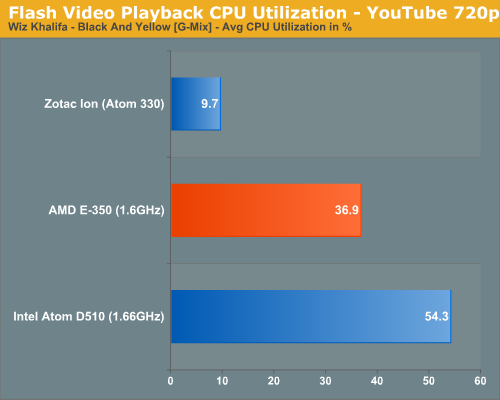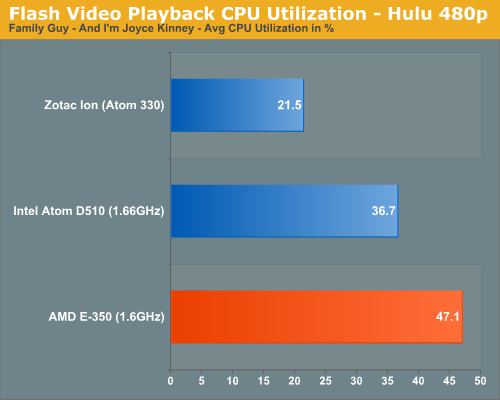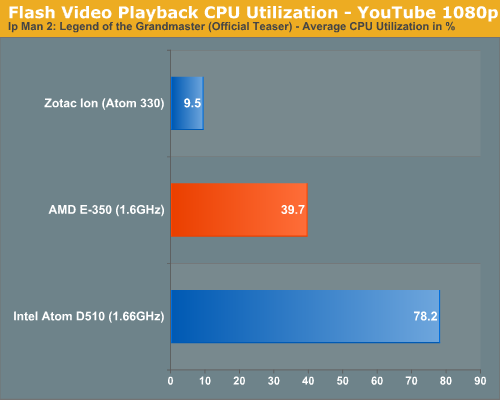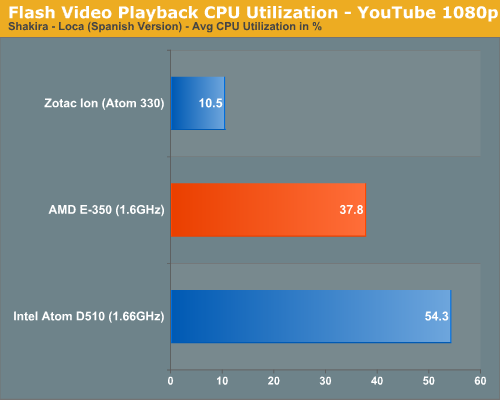The Brazos Review: AMD's E-350 Supplants ION for mini-ITX
by Anand Lal Shimpi on January 27, 2011 6:08 PM ESTBlu-ray & Flash Video Acceleration
Compatibility is obviously a strongpoint of Brazos. So long as what you’re decoding can be hardware accelerated you’re pretty much in the clear. But what about CPU utilization while playing back these hardware accelerated formats? The CPU still needs to feed data to the GPU, how many cycles are used in the process?
I fired up a few H.264/x264 tests to kick off the investigation. First we have a 1080p H.264 Blu-ray rip of Quantum of Solace, averaging around 15Mbps:
| Quantum of Solace 1080p H.264 CPU Utilization (1:00 - 1:30) | |||||
| Platform | Min | Avg | Max | ||
| AMD E-350 | 22.7% | 27.8% | 35.3% | ||
| Intel Atom D510 | Fail | ||||
| Zotac ION | 14.6% | 17.2% | 20.1% | ||
A standard Atom platform can’t decode the video but ION manages a 17% average CPU utilization with an Atom 330. Remember that the Atom 330 is a dual-core CPU with SMT (4-threads total) so you’re actually getting 17.2% of four hardware threads used, but 34.4% of two cores. The E-350 by comparison leaves 27.8% of its two cores in use during this test. Both systems have more than enough horsepower left over to do other things.
Next up is an actual Blu-ray disc (Casino Royale) but stripped of its DRM using AnyDVD HD and played back from a folder on the SSD:
| Casino Royale BD (no DRM) CPU Utilization (49:00 - 49:30) | |||||
| Platform | Min | Avg | Max | ||
| AMD E-350 | 28.1% | 33.0% | 38.4% | ||
| Intel Atom D510 | Fail | ||||
| Zotac ION | 17.7% | 22.5% | 27.5% | ||
Average CPU utilization here for the E-350 was 33% of two cores.
Finally I ran a full blown Blu-ray disc (Star Trek) bitstreaming TrueHD on the E-350 to give you an idea of what worst case scenario CPU utilization would be like on Brazos:
| Star Trek BD CPU Utilization (2:30 - 3:30) | |||||
| Platform | Min | Avg | Max | ||
| AMD E-350 | 29.0% | 40.1% | 57.1% | ||
At 40% CPU utilization on average there’s enough headroom to do something else while watching a high bitrate 1080p movie on Brazos. The GPU based video decode acceleration does work, however the limits here are clear. Brazos isn’t going to fare well as a platform you use for heavy multitasking while decoding video, even if the video decode is hardware accelerated. As a value/entry-level platform I doubt this needs much more explanation.
Now let’s talk about Flash.
I ran through a number of Flash video tests at both YouTube and Hulu ranging in resolution from 480p all the way up to 1080p. I used Flash 10.1, 10.2 beta as well as an unreleased version of 10.2 beta provided by AMD.


For the most part GPU accelerated Flash video does work well. Performance under both YouTube and Hulu was flawless, provided that I wasn’t watching 1080p content. Watching 1080p content in YouTube wasn’t entirely smooth on Brazos, despite posting very reasonable CPU utilization numbers.


I took my concerns to AMD and was told that this was a known issue with Brazos and Flash 10.1 and that 10.2 should alleviate the issue. AMD then supplied me with an unreleased version of Flash 10.2 to allow me to verify its claims. While 1080p playback improved with AMD’s 10.2 beta, it wasn’t perfect (although it was very close). AMD wouldn’t tell me the cause of the problem but it’s currently working on it with Adobe. At the end of the day I don’t believe it’s a dealbreaker, but early Brazos adapters should expect some stuttering when playing back 1080p YouTube videos. Note that 720p and lower resolution videos were perfectly smooth on Brazos.










176 Comments
View All Comments
StardogChampion - Friday, January 28, 2011 - link
A low-powered mini-ITX board with 4-5 SATA III ports, maybe a eSATA (Hudson FCH supports 6 x SATA) port and PCI-e slot for adding a SATA controller card (even if it's x4 it's still better than PCI) for $100 has me thinking home server. I don't see a board out there that comes close to these features at this price. If you want a D510 board with 6 x SATA II you have to shell out $200. Take one of these E-350 mini-itx boards, put it in a Lian-Li Q08 case with a bunch of 2TB drives, Amahi/WHS/etc. and you've really got something. It's a waste of GPU but how do you beat it?And, for building friends/family/neighbors desktops to replace the big outdated tower sitting on the floor that they just use for surfing, email, MS Office: once this comes out I'll never build another big tower again.
fr500 - Friday, January 28, 2011 - link
Using mainstream games for this reviews make little sense. It would be better to show it with some good indie games at 720p, say super meat boy (won't run well on an i3 530's IGP or an 9300-ITX IGP for instance it needs good steady FPS to be playable).Maybe Braid, Trine, Torchlight.
I don't see many people using this for MW2.
ProDigit - Friday, January 28, 2011 - link
I would have preferred to see the E-350 compared to an Atom N550,especially with power consumption.I believe the N550 beats the crap out of the E-350 (power-wise). After all, I guess AMD wants to put this apu in netbooks, no?
LeftSide - Friday, January 28, 2011 - link
Does anybody know if bobcat is going to support ecc ram? I want to build a low power server with ecc ram.msroadkill612 - Friday, February 4, 2011 - link
I have read it doesntAmdInside - Friday, January 28, 2011 - link
Will it run Angry Birds?kenyee - Friday, January 28, 2011 - link
Wish you touched more on that...that's listed as a weakness, but nothing about whether anything this year will be able to decode 3D bluray movies...bjacobson - Saturday, January 29, 2011 - link
what are people using OpenCL at this point these days for anyways?spiked_mistborn - Saturday, January 29, 2011 - link
I agree with you geekfool. Where are the OpenCL or DirectCompute benchmarks (especially OpenCL since that is cross-platform and seems to be building steam)? This article does not feel complete without some type of GPU acceleration test since that is one idea that AMD has been pushing since we first started hearing about fusion. The idea was that the low performance of the cpu core on compute intensive workloads could be compensated for by shifting highly parallel workloads to the SPs. If I remember correctly Intel recently released OpenCL support for their CPUs, and there are also upcoming ARM based SOCs that will have OpenCL support.While OpenCL may not matter to everybody today, I think that in a couple of years any devices that are released that don't support it will be skydiving without a parachute.
Klimax - Saturday, January 29, 2011 - link
Just few things:What board with D510 was used and was it with latest BIOS?
I have noticed that after new BIOS is loaded on intel boards I get about ~20% increase in write and ~10% in read performance on SSD. Along with few percent on graphics benches. (Tested between October and January)
Could somebody here test it? (I used BLKD510MO as cheapest D510 board with 1GB DDR2 and Win7 x64 and cheap Kingston SSD)
This is somewhat missing IMHO.
Thanks.